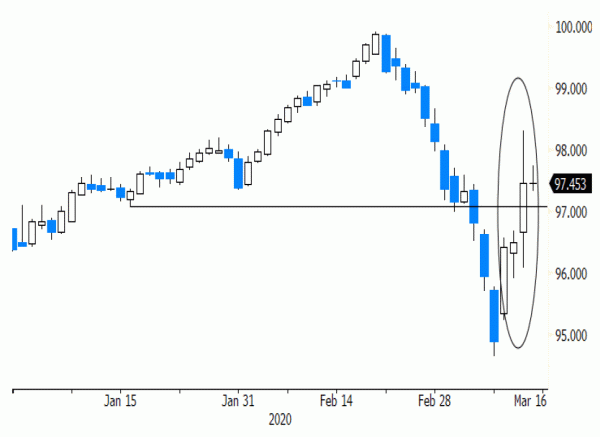- Rates: Dash for cash
ECB Lagarde’s screw-up horrible trading day into a catastrophic one. Her remark during the central bank’s press conference that the ECB is “not here to close spreads” sent stock markets and peripheral bond markets into tailspin. This week’s crisis mode on financial markets results in a significant dash for cash with investors getting rid of all illiquid assets. - Currencies: Hunt for liquid assets favours the dollar
The USD outperformed as investors favour the most liquid currencies. EUR/USD dropped as ECB’s Lagarde indicated that the central bank didn’t intend to aggressively narrow intra-EMU spreads and only recovered part of this loss on Fed liquidity operations. The dollar probably retains the benefit of the doubt as long as market stress remains extremely elevated
The Sunrise Headlines
- US stocks were in freefall in their worst day since the 1987 Black Monday crash. All three indices entered bear market territory with losses up to -10% (DJI). Asian markets follow the spooky WS session. South Korea underperforms (-7%).
- The Fed pledged to pump $5 trillion of liquidity into markets over the next month to counter a surge in ST funding rates. The Fed will also widen the scope of its purchases of US government securities to include more than just T-bills.
- Russian oil producers (e.g. Gazprom and Tatneft) are digging deeper in their draw with the Saudis, announcing they can jack up their output from April 1 onwards and are able to withstand further oil price drops.
- US House Speaker Nancy Pelosi disclosed the House of Representatives is nearing an agreement with the Trump administration on a coronavirus economic aid package, adding she hoped to announce the deal today.
- The RBA provided substantial additional liquidity today through A$8.8 bn repo operations, more than twice the amount it had originally intended, in a bid to counter possible funding crunches as investors panic over the coronacrisis.
- According to DJ, the BoJ sees no demand for coordinated rate cuts by CBs and is reluctant to cut rates further. Instead, the BoJ is inclined to step up purchases of ETFs and provide aid for businesses affected by the corona outbreak.
- Today’s economic calendar contains final February CPI figures in Europe (Germany, France and Spain) and U. of Michigan Sentiment indicator in the US which is likely to reflect mounting worries over the coronacrisis.
Currencies: Hunt For Liquid Assets Favours The Dollar
Dollar outperforms as liquidity is key
Yesterday, the ECB didn’t cut rates but eased conditions on TLTROs and raised the amount of bond purchases. The dollar was already well bid in the run-up to the ECB decision, probably as the USD is seen as the most liquid currency. At the press conference, ECB’s Lagarde suggested that the bank won’t aggressively narrow intra-EMU spreads. This caused further selling of EMU equities and the euro. Later, the Fed announced massive repo operations, including bond buying across the yield curve. This eased the rise of the dollar, even as the reaction was uneven across different cross rates. EUR/USD rebounded and closed at 1.1185, still below the 1.1250 technical level. USD/JPY ceded part of an intraday rebound to close at 104.68. Smaller, less liquid currencies mostly were again in free-fall, irrespective of their eco fundamentals.
Overnight, Asian equities opened again with steep losses after the sell-off on WS, but indices regained some ground off the intraday lows. Liquidity remains a key factor for FX trading, with smaller currencies still in the defensive. Still, the yuan reversed a big part of yesterday’s decline (USD/CNY currently again below the 7.00 mark). USD/JPY also keeps an upward bias (105.50 area) as the BOJ and the MOF discussed a coordinated crisis response. EUR/USD is holding a remarkably stable trading pattern near the 1.12 level.
Markets are looking out for a more coordinated policy response today or during the weekend. Yesterday’s price action suggests that liquidity is the dominant factor for currency trading as long as market stress stays at extremely elevated levels. For now, the euro apparently stays second best, rather than the yen, even as Lagarde’s comments on intra-EMU bond spreads highlighted potential ‘institutional fragility’. The expectation of more aggressive Fed easing still might weigh on the dollar over time but this factor apparently will only come again on the radar when the extreme market stress and hunt for (USD) cash abates. Earlier this week, we assumed the dollar to be captured in a sell-on upticks pattern with EUR/USD 1.1250 a potential floor. This assumption is more or less rejected after yesterday’s price action, making the EUR/USD picture again more neutral, or even slightly in favour of the dollar ST.
Yesterday, sterling stayed under pressure, even against the euro, as the UK currency is less liquid compared to the other major currencies. EUR/GBP tried to extend gains beyond 0.89 overnight, but the move shows tentative signs of slowing. As is the case for other smaller currencies, any sterling rebound probably needs global tensions to ease.
USD trade weighted (DXY) dollar outperforms as hunt for liquidity prevails













